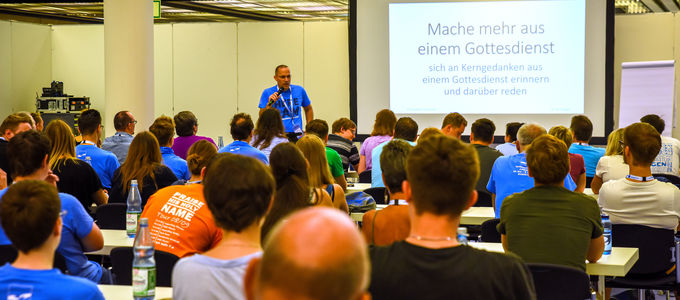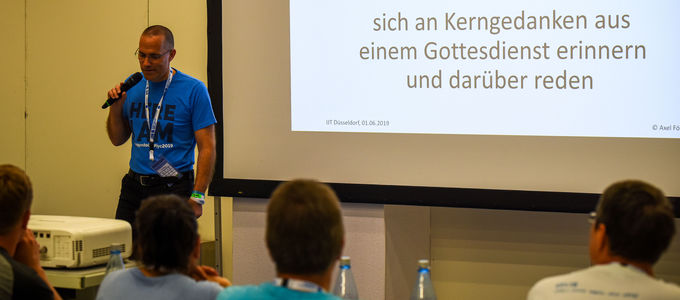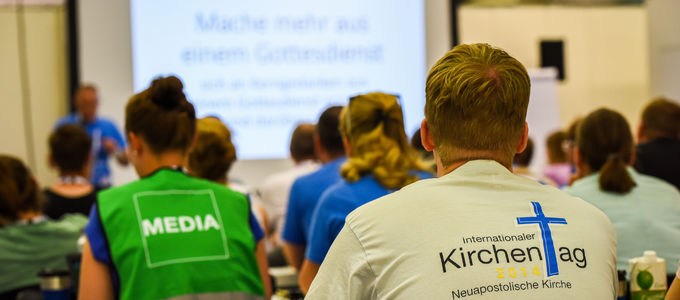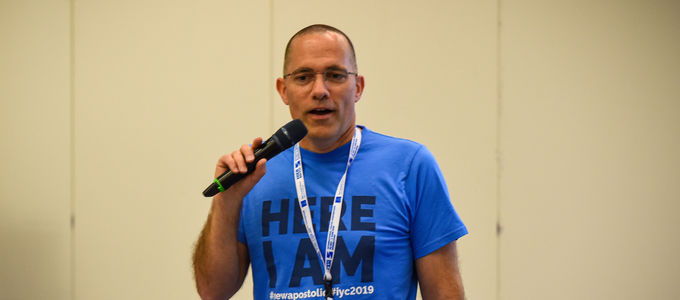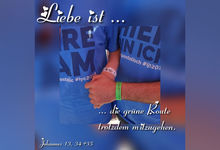Ideas from the IYC: memory training for the soul
Not all divine services are the same: some have an effect that lasts a lifetime. And others have already all but faded into oblivion by the time you get home from church. So how do you manage to take more out of a divine service? There’s a trick for that.
“We need a stimulus in order to retain things and call them to mind again later on,” explained Axel Föllinger, a Priest from the south of Germany, during the International Youth Convention (IYC) in his workshop on mnemonics. “Every day I see the same road signs on the way to work, but I still do not have them in my head.” This is because we tend to be better at committing extraordinary things to memory—especially emotional, funny, or painful information.
“Being a Christian begins in daily life, after the divine service is over,” Axel Föllinger reminds his audience. Our task is to recognise core thoughts and link them together so that we can retain them. Mnemonics is a tool that can help with this. Since 2013 he has been engaged in studying the art of memory, an art which was already used in ancient times.
Step 1: establish anchor points
Using mnemonics requires a natural sequence or order of things that is easy to remember. Axel Föllinger showed us how to do this. He created ten anchor points which he could use to establish links with various thoughts. His memory hook: a tour through his home congregation. (1) the display case at the entrance, (2) the Deacon at the door, (3) the wardrobe, (4) the offering box, (5) the organ, (6) the hymnal, (7) the altar, (8) the Bible, (9) the patens, and (10) the emblem.
Step 2: create an image database in the brain
How does one retain a thought from a sermon or presentation? By associating a key piece of information with an image. Here it will suffice to retain a key word in order to remember the entire context. For example, a thought may have to do with Christian values. What image pops into your mind? It could be the image of a treasure chest. There is no right or wrong answer. Each individual builds his or her own image data base in his or her own head.
Step 3: link images and anchor points
The third step is to associate the image with the first anchor point. For example, in the display case in front of the church there is a treasure chest. This principle can be continued with other thoughts from a sermon or a presentation. The individual images (step 2) are stored in the previously defined order (step 1). So it is that a story with many individual memory hooks comes into being, which can also be called to mind more easily later on.
Step 4: try it out and don’t give up!
Mnemonics requires practice. “You have to be open to it and want to learn the technique. Don’t be annoyed if it doesn’t work immediately,” says Axel encouragingly.
A practical test
I resolved to take my first step over the IYC weekend. For the closing divine service of the youth convention I decided on a list from the body and begin with five anchor points: (1) feet, (2) knees, (3) hips, (4) heart, (5) ears.
- First core thought: at the beginning of the divine service, the Chief Apostle talks about the dual perspective of the IYC motto: “Here I am.” I am here. But God is here too. I link “Here I am” with the fact that one is present, takes a position, and stands on one’s own “feet”.
- Second core thought: as a Christian community, we want to share the love that God has given each individual human being. I associate the love of God with an image of hands that always catch me. And I link this image to my second anchor point—the knees.
- Third core thought: now things are becoming more concrete. What does it mean to share the love of God and pass it along to others? Jesus accepted all people, and did not divide them into categories such as rich or poor, young or old, sick or healthy. In my mind’s eye, I see an image of the drawers to which we so often assign people. I associate the drawers with the pant pockets of my third anchor point—the hips.
- Fourth core thought: when we pass along the love of God, this also means that we share both joy and suffering with one another, help one another, and pray for one another. In this case, my association once again coincides with my next anchor point—the heart.
- Fifth core thought: praying for one another and supporting our neighbour in our thoughts is good, but sharing and passing along the love of God also requires a physical effort. It means taking action, getting to work, and tackling the situation. I deviate a little from my original plan and spontaneously create a new anchor point, namely “hands”.
- Sixth core thought: the Chief Apostle reminds the large IYC congregation to seek fellowship, to speak to one another, to exchange thoughts—not only digitally, but rather in real life, in a face-to-face setting. For me, this core thought matches with another anchor that I create on the spot, namely the mouth.
- Seventh core thought: passing the love of God along and sharing it with others is also a task that unites all Christian churches with one another. In my mind I see the image of a vision that comes into being in the brain—and I connect this thought with the anchor point “head”.
- Eighth core thought: when he served along, District Apostle Michael Deppner reminded us about another characteristic of the way Jesus shared His love. He pointed out that Jesus washed the feet of His disciples, and that he performed this service upon all of them—including Judas, the disciple who would later betray Him. The main message here is that Jesus takes a broader view of things. He already knew that His disciple would take his own life and would need salvation. Taking a broader view, changing one’s perspective—I associate this thought with yet another new anchor point, namely the eyes.
My conclusion, it was certainly worth a try! I didn’t take a single note in the closing divine service of the IYC, even though I was supposed to write an article about my own attempt at using mnemonics. I simply wrote everything from memory. And that is a pretty cool feeling!
Article info
Author:
Date:
Keywords:
Redaktion IJT2019
18.06.2019
International Youth Convention 2019 (IYC),
Divine service


